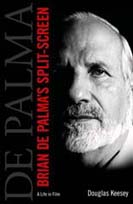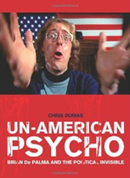"IT'S HARD TO THINK OF A DIRECTOR WHOSE WORK YIELDS MORE REWARDS ON REPEAT VIEWINGS"
 Screenwriter/director Jim Hemphill has posted an article in anticipation of the American Cinematheque series on Brian De Palma, which begins next week. "It takes a lot of confidence to begin a movie with a clip from perhaps the most famous film noir of all time," begins Hemphill in the article, "as Brian De Palma does in the first scene of his 2002 erotic thriller Femme Fatale. That film’s opening scene, which unfolds via a virtuoso long take in which we're introduced to the lead character and major themes of the film without a cut, begins with an image from Billy Wilder’s Double Indemnity on a television and ends with a hotel room curtain being pulled aside to reveal the Cannes Film Festival red carpet. Inviting comparison with Wilder and referencing the most prestigious film festival on earth makes a bold statement right off the bat, but De Palma doesn’t merely invite the comparisons he’s making – he earns them, and then goes beyond Wilder’s influence to create a film that is both a superb example of the film noir form and a commentary on it, as well as an evolutionary step forward in terms of the tradition’s approach to women. While it would be a stretch to call Femme Fatale a feminist manifesto, in its own sly way it answers the charges of misogyny often leveled against film noir by setting in motion a gleefully complicated puzzle of a plot in which one commanding man after another finds his sense of order disrupted by the female jewel thief at the movie’s center. It’s not just that Laure (Rebecca Romjin) undermines the guys and their world; De Palma himself subverts a century of established cinematic 'rules' to place the audience in the position of the bewildered men stripped of their power – and he does it with so much pizzazz that we’re grateful to have the rug pulled out from under us."
Screenwriter/director Jim Hemphill has posted an article in anticipation of the American Cinematheque series on Brian De Palma, which begins next week. "It takes a lot of confidence to begin a movie with a clip from perhaps the most famous film noir of all time," begins Hemphill in the article, "as Brian De Palma does in the first scene of his 2002 erotic thriller Femme Fatale. That film’s opening scene, which unfolds via a virtuoso long take in which we're introduced to the lead character and major themes of the film without a cut, begins with an image from Billy Wilder’s Double Indemnity on a television and ends with a hotel room curtain being pulled aside to reveal the Cannes Film Festival red carpet. Inviting comparison with Wilder and referencing the most prestigious film festival on earth makes a bold statement right off the bat, but De Palma doesn’t merely invite the comparisons he’s making – he earns them, and then goes beyond Wilder’s influence to create a film that is both a superb example of the film noir form and a commentary on it, as well as an evolutionary step forward in terms of the tradition’s approach to women. While it would be a stretch to call Femme Fatale a feminist manifesto, in its own sly way it answers the charges of misogyny often leveled against film noir by setting in motion a gleefully complicated puzzle of a plot in which one commanding man after another finds his sense of order disrupted by the female jewel thief at the movie’s center. It’s not just that Laure (Rebecca Romjin) undermines the guys and their world; De Palma himself subverts a century of established cinematic 'rules' to place the audience in the position of the bewildered men stripped of their power – and he does it with so much pizzazz that we’re grateful to have the rug pulled out from under us."Below is the closeing paragraph from Hemphill's article, and you can read the whole thing at American Cinematheque.
De Palma’s career is all the more remarkable for his ability to adapt to changing circumstances – both his own and those of the film industry at large. Regardless of the size of his canvas, the potency of his vision is undiluted, whether he’s working in the low-budget experimental realm (as in Redacted or early apprentice efforts like Murder a la Mod and Dionysus in ’69) or on the kinds of big-budget tent-poles that stifle less robust personalities. When De Palma takes a studio assignment on a film like The Untouchables or Mission: Impossible, he fuses his own preoccupations with the demands of the material in a way that serves both; his stylistic and thematic obsessions expand to broader dimensions thanks to their expression in a new form, and the films’ escapist set-pieces are more entertaining and charged with energy because of the artistic drives motivating them. There’s never any sense of De Palma following the old “one for me, one for them” (them being the studio) formula in his career – they’re all for him, and they’re all for us. It’s hard to think of a director whose work yields more rewards on repeat viewings, or whose dense visual representations and allusions gain more from being experienced on the big screen –making the Cinematheque’s retrospective one of the essential repertory events of 2016 thus far.



